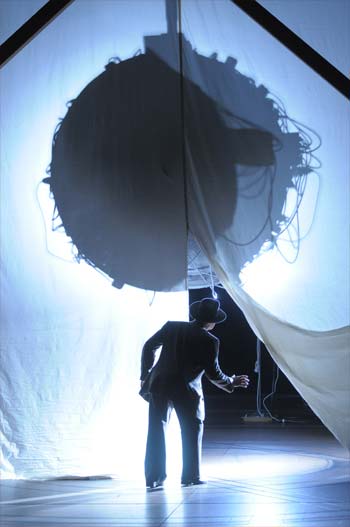This summer, the Santa Fe Opera will perform composer John Adams’s Doctor Atomic. Commissioned by the San Francisco Opera in 2005 and performed in Chicago, New York, London and Amsterdam, this is the first time the opera will be performed in New Mexico, the epicenter of the opera.
The opera concentrates on the weeks just before the Trinity test on July 16, 1945. With a libretto by Peter Sellars, the opera is a powerful interpretation in words and music of the scientific, political, moral and ethical tensions inherent in the birth of the atomic bomb.
The Atomic Heritage Foundation (AHF) is developing an online interpretive program, “Doctor Atomic Trail,” to complement the opera. AHF is partnering on this project with the Santa Fe Opera, the New Mexico History Museum, Los Alamos Historical Society, the National Museum of Nuclear Science and History, White Sands Missile Range Museum, and the Northern Rio Grande National Heritage Area.
The program will be part of the “Ranger in Your Pocket” series and explore Manhattan Project sites in Lamy, Santa Fe, Los Alamos, Española, and the Trinity Site. For example, a program on Santa Fe’s 109 East Palace will feature interviews with Jennet Conant, author of 109 East Palace, and Dorothy McKibbin, the “Gatekeeper of Los Alamos” who presided there. AHF will create engaging audio/visual vignettes with first-hand accounts from Manhattan Project participants taken from the “Voices of the Manhattan Project” oral history collection.
The Trinity Site program will present eyewitnesses recalling their feelings of relief, awe and foreboding as the mushroom cloud rose. With these and other accounts, the program should be a valuable resource for opera fans, tourists, students, and audiences worldwide. A beta version will be available before the opening night of Doctor Atomic on Saturday, July 14.
The Trinity test marked the beginning of the “Atomic Age.” The program will present multiple perspectives on the test’s significance and legacies, from the subsequent use of atomic weapons against Japan to the stories of downwinders affected by the test. The program will explore the impacts of the Manhattan Project today, and help the public better understand the sites in New Mexico where it took place. After the beta version is released, AHF plans to expand the program in 2019.
The program will feature 109 East Palace Avenue in Santa Fe, which initially served as an office for J. Robert Oppenheimer, director of the Manhattan Project’s scientific laboratory. After Oppenheimer and other top-echelon scientists moved to Los Alamos, Dorothy McKibbin took over the office where she worked from 1943 until 1963.
McKibbin’s job was to orient the bewildered scientists who reported to her offices in Santa Fe, not knowing their ultimate destination. “We averaged about 67 people in there per day and 110 telephone calls per day,” she remembered. “We were really very busy.” McKibbin reassured them, issued passes, assigned housing and provided transportation to Los Alamos.
“Doctor Atomic Trail” will also feature the train station in Lamy, where weary Manhattan Project recruits arrived after days of travel. Army personnel picked them up for the ten-mile trip to Santa Fe, where they faced another 35-mile trip to their ultimate destination. In addition, the Santa Fe chapter will include La Fonda, whose bar became a favorite watering hole for scientists and their wives.
 At Los Alamos, the program will focus on the homes on “Bathtub Row,” where top-echelon scientists resided during the Manhattan Project. Vignettes about the Oppenheimer House will include one of J. Robert Oppenheimer recalling, “We lived about a third of a mile from the laboratory,” Oppenheimer remembered. “I would try to get to the laboratory on normal days about eight or something like that and take our son to the nursery school on the way.”
At Los Alamos, the program will focus on the homes on “Bathtub Row,” where top-echelon scientists resided during the Manhattan Project. Vignettes about the Oppenheimer House will include one of J. Robert Oppenheimer recalling, “We lived about a third of a mile from the laboratory,” Oppenheimer remembered. “I would try to get to the laboratory on normal days about eight or something like that and take our son to the nursery school on the way.”
The Manhattan Project had a profound impact on northern New Mexico. Many members of local Pueblo and Hispano communities worked at Los Alamos from its inception in early 1943. Short of laborers, the Army Corps of Engineers recruited them to help build and maintain the laboratory and residences. Hundreds served as construction workers, janitors, housekeepers, technicians, clerks, mess hall staff, mail couriers, maids and other roles.
Trucks and green Army buses stopped at the Hispano communities and the Pueblos each morning to pick up workers and take them to jobs on “The Hill,” as Los Alamos was called. “Each little community had a bus that people from the valley would ride,” remembered Lydia Martínez, who grew up in the nearby community of El Rancho and worked at Los Alamos during the Manhattan Project.
The project will include different perspectives from Willie Atencio and David Schiferl’s collection of oral history interviews with people from northern New Mexico. Some workers welcomed the steady, well-paying jobs at the laboratory. Later, many expressed concerns over environmental contamination, health effects, and disruptions to traditional ways of life.
For more information about Doctor Atomic, visit the Santa Fe Opera’s website. AHF thanks the National Trust for Historic Preservation, White Sands Missile Range Historical Foundation, Clay and Dorothy Perkins and other contributors for their generous support for this project.





